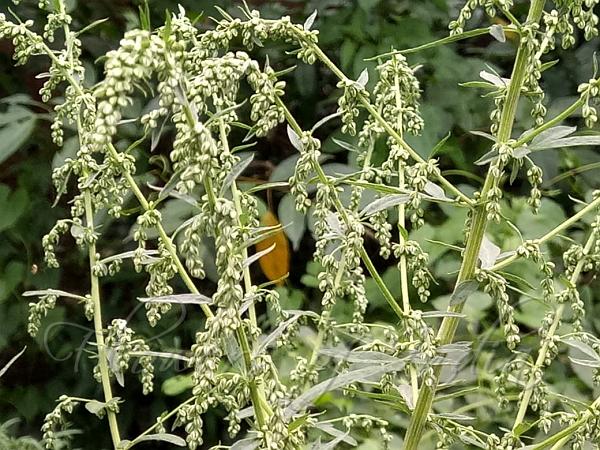|
| Indian Wormwood |
|

|

|
|
|
|
Photo: |
Botanical name: Artemisia indica Family: Asteraceae (Sunflower family)
Synonyms: Artemisia indica var. nepalensis, Artemisia asiatica
Synonyms: Artemisia indica var. nepalensis, Artemisia asiatica
Indian Wormwood is a perennial herb, or subshrubs,
80-150 cm tall, much branched, sparsely finely velvet-hairy or becoming
hairless. Leaves are shortly stalked or stalkless; leaf blade below
densely gray arachnoid woolly, above gray or yellowish woolly or
becoming hairless. Lowermost leaves ovate or oblong-ovate, 6-12 × 3-8
cm, 1 or 2-pinnately cut; distal lobes larger; segments 3 or 4 pairs,
winged at midvein. Middle stem leaves ovate, oblong-ovate, or elliptic,
5-8 × 3-5 cm, 1 or 2-pinnately parted; segments 3 or 4 pairs; distal
lobe larger; lobes elliptic-lanceshaped, linear-lanceshaped, or linear,
10-20 × 3-5 mm; lobules deeply sawtoothed, pointed or tapering
apically. Uppermost leaves pinnatipartite; leaflike bracts 3-lobed or
entire. Flower-heads are stalkless or short-stalked, erect, borne in
broadly conical, almost leafless panicle with obliquely spreading, up
to 18 cm long branches. Involucre ovoid, oblong-ovoid, or broadly
ovoid, 3-4 × about 2 mm; phyllaries finely velvet-hairy to hairless.
Florets are 15-20, yellowish, all fertile. Marginal female florets
4-10; flower tubular, ± glandular, 2-toothed. Disk florets are 8-12,
bisexual, basally glandular. Achenes are brown, oblong or obovoid,
about 1.25 mm. Indian Wormwood is found in India and East Asia. It is
found in the Himalayas at altitudes of 300-2400 m.
Flowering: August-October.
Medicinal uses: An infusion of leaves is used
in the treatment of nervous and spasmodic affections, in asthma and in
diseases of the brain. This infusion is also considered to be helpful
in improving the appetite. The juice of the plant is used in Nepal to
treat diarrhoea, dysentery and abdominal pains. It is used as an
eyewash where it is said to relieve the burning sensation in
conjunctivitis. A paste of the plant is applied externally to treat
wounds. The roots are antiseptic and are a tonic for the kidneys.
An infusion of leaves is used
in the treatment of nervous and spasmodic affections, in asthma and in
diseases of the brain. This infusion is also considered to be helpful
in improving the appetite. The juice of the plant is used in Nepal to
treat diarrhoea, dysentery and abdominal pains. It is used as an
eyewash where it is said to relieve the burning sensation in
conjunctivitis. A paste of the plant is applied externally to treat
wounds. The roots are antiseptic and are a tonic for the kidneys.
Medicinal uses:
 An infusion of leaves is used
in the treatment of nervous and spasmodic affections, in asthma and in
diseases of the brain. This infusion is also considered to be helpful
in improving the appetite. The juice of the plant is used in Nepal to
treat diarrhoea, dysentery and abdominal pains. It is used as an
eyewash where it is said to relieve the burning sensation in
conjunctivitis. A paste of the plant is applied externally to treat
wounds. The roots are antiseptic and are a tonic for the kidneys.
An infusion of leaves is used
in the treatment of nervous and spasmodic affections, in asthma and in
diseases of the brain. This infusion is also considered to be helpful
in improving the appetite. The juice of the plant is used in Nepal to
treat diarrhoea, dysentery and abdominal pains. It is used as an
eyewash where it is said to relieve the burning sensation in
conjunctivitis. A paste of the plant is applied externally to treat
wounds. The roots are antiseptic and are a tonic for the kidneys.
| Identification credit: Tabish | Photographed in Pasighat, Arunachal Pradesh |
• Is this flower misidentified? If yes,